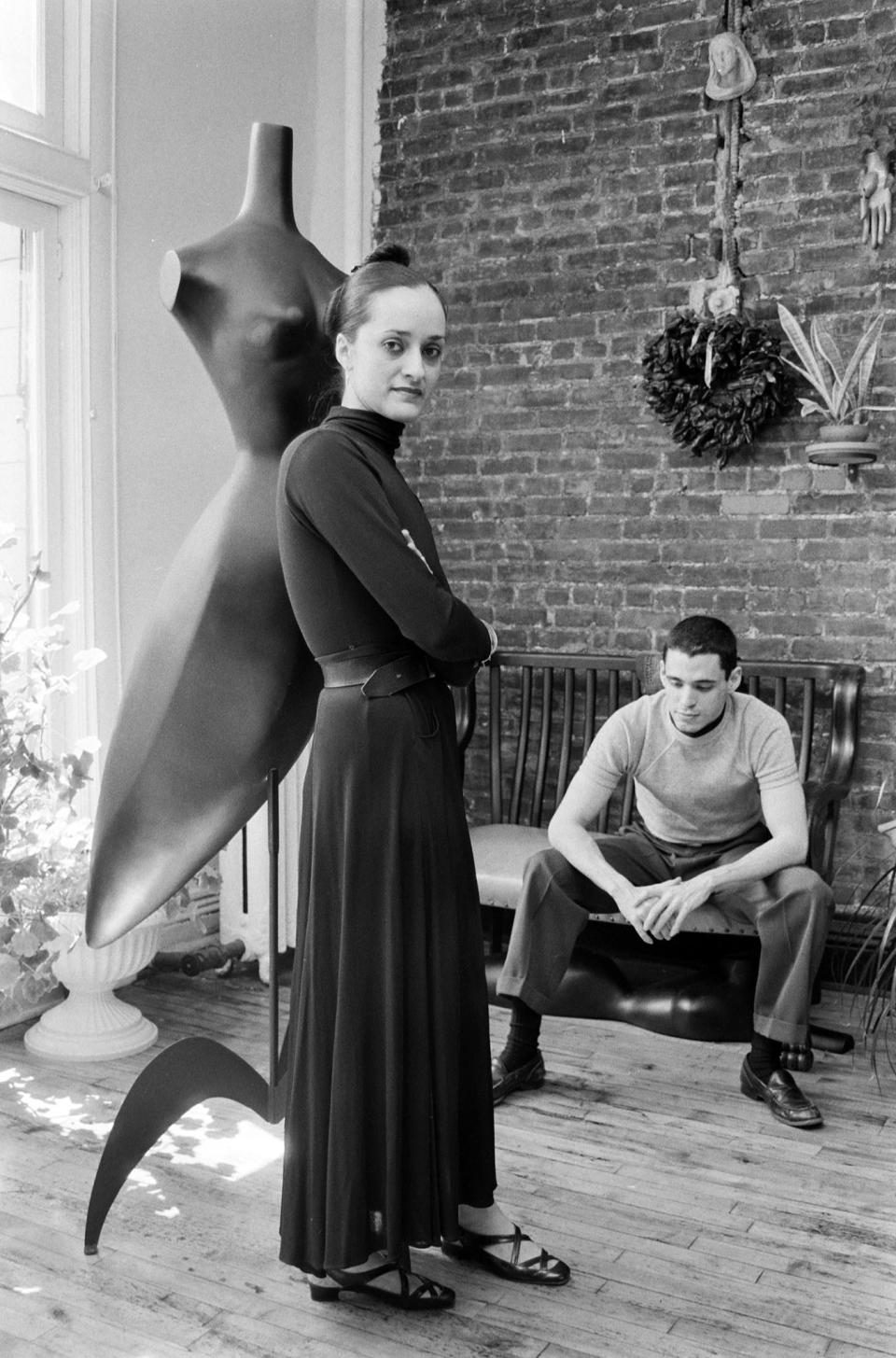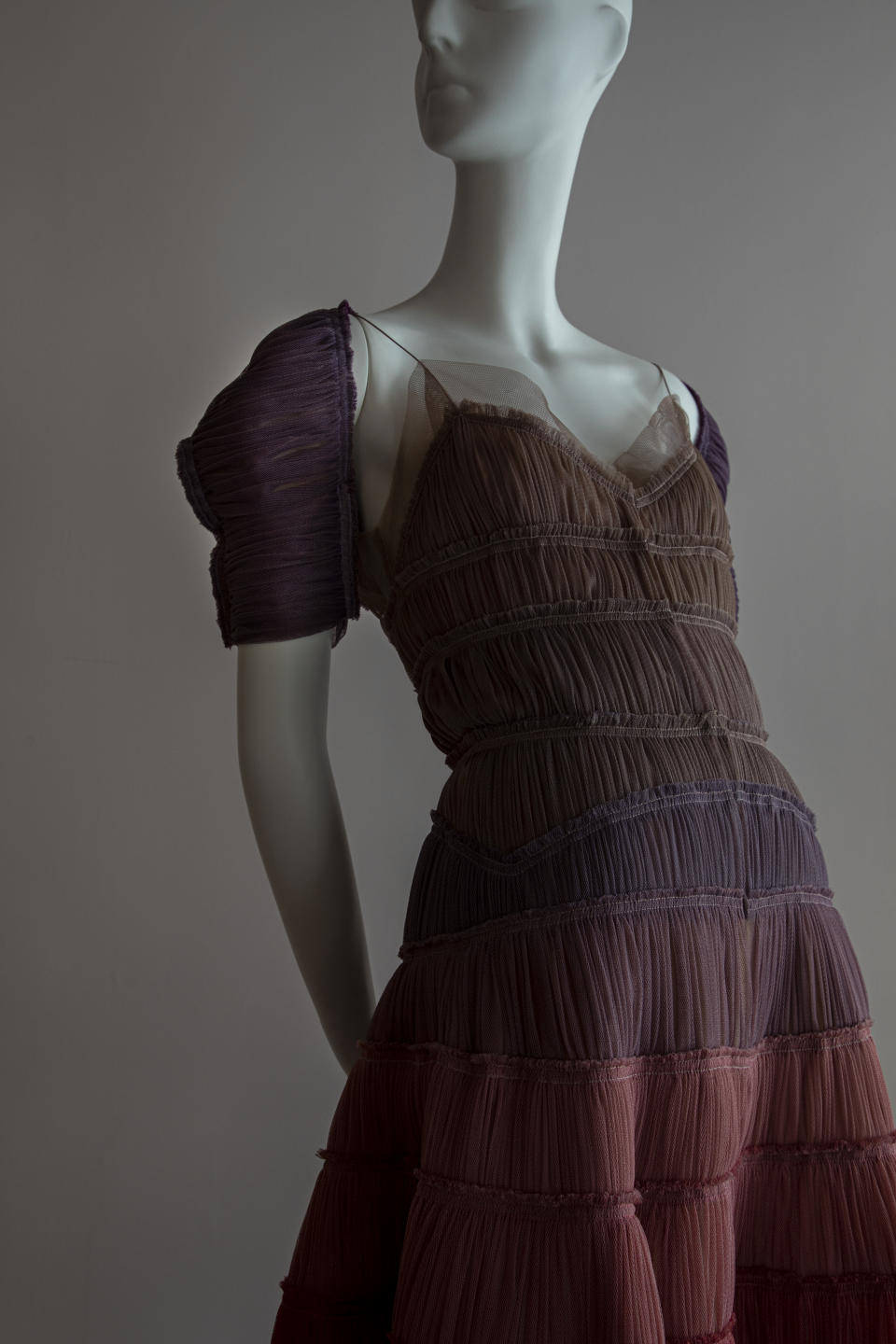Ruben Toledo on His ‘Love Letter’ to Isabel Toledo
- Oops!Something went wrong.Please try again later.
- Oops!Something went wrong.Please try again later.
- Oops!Something went wrong.Please try again later.

PARIS — The opening of “Isabel Toledo: A Love Letter” at the Savannah College of Art and Design’s new permanent fashion museum in the South of France had a special emotional resonance for her husband, Ruben Toledo.
The exhibition’s inauguration on Saturday took place on what would have been the Cuban-born American designer’s 62nd birthday. And since Ruben Toledo’s birthday is on April 10, she liked to turn it into a monthlong celebration.
More from WWD
“She didn’t like schedules, and that’s why she didn’t show every single season and collection. Once she could get out of that, she loved it,” Toledo told WWD by Zoom from the picturesque village of Lacoste in Provence. “It was my job to keep on the schedules and the deadlines so that she could just freely float. She hated the monotony of routines and all that.”
The artist, known for his illustrations for clients including Louis Vuitton and Nordstrom, spoke movingly of his decades-long partnership with Isabel Toledo, who passed away in 2019.
He talked about how they sparked off each other’s differences; how two political refugees from Cuba became the darlings of the New York City club scene in the late ‘70s and early ’80s; how Toledo’s twin love of haute couture and workwear informed her exacting, experimental designs, and how First Lady Michelle Obama put the designer’s designer on the map.
He hopes the exhibition will inspire students today, and give European audiences a better insight into American design thinking. “There was a point where Isabel was preferring to do museum shows than to do runway shows, because she said, this is so much more satisfying, because you share the story, and you see its effect on these young minds,” he said.

Thomas Iannaccone/WWD
WWD: It must be quite an emotional process for you to work on this exhibition. How did you want to honor the creative partnership that you and Isabel had together?
Ruben Toledo: People assume that to collaborate and work together, you have to be alike or think alike, and it’s quite the opposite, and we’re living proof of that. The friction caused by the difference is what creates something very new, because Isabel’s aesthetic and my aesthetic are completely different, and our working methods are completely different. Our outlook on everything is different, from food, to weather, to temperature, including art and clothes — very, very different aesthetics. And that’s what made the work interesting and multifaceted, and it makes it modern and last long.
We knew what we were good at, but always interrupted or interfered in the other one’s territory, and so there were no clear borders on who did what, and where did something start and something finish. So I think it was always important for us to let students understand that. It just frees your ego to create.
WWD: That’s so interesting, because just looking at the images of you two together, I would have assumed instinctively that you were two peas in a pod.
R.T.: So many of our friends even said, “You guys finish each other’s sentences.” And we always said, yes, we do, but in a Dada poetry way. It’s not what you expect the ending to be.
But I think that was part of it, you appreciate what’s been added that’s completely something you would never have thought of. It’s a new ingredient put into the stew.
WWD: Can you tell me a little bit about how Isabel’s clothing inspired you concretely in terms of your illustrations and your art?
R.T.: Isabel never sketched. She could draw, but when she met me, she said she stopped drawing because she thought I did it so much better than she did, so that was always my job. She would describe an outfit gesturally, or even talking about body language and an emotion to describe what she wanted, shape it with her hands in the air, and I would try to capture that as a sketch. That was a starting point. Then from there, she would start creating clothes and the architecture of her patterns.
Her patterns to me were like modern art. They were just these incredible graphic symbols, and not having been a fashion designer or trained in that world, just to understand that these solid graphic shapes, whether they were symmetrical or asymmetric, ended up being this fluid, beautiful, elegant thing, that kind of blew my mind — how she went from a flat, very solid, very clearly defined thing to this kind of amorphous, ethereal, floating in the wind thing. So part of the exhibition shows, when you’re looking at one of the garments, how the pattern pieces laid out are almost like an animal skin or a dissected human. You see all the body parts that make up this garment.
And I think it’s an unappreciated part of what fashion designers do. People assume it’s this beautiful fluff of air, this beautiful million tons of tulle. They don’t understand the geometry and the engineering that goes into making that.

AP Photo/Charles Dharapak
WWD: How will your art be featured in the exhibition?
R.T.: We have actual live sketchbooks open. We have ink drawings that I do, based on Isabel’s patterns. We have fashion sketches. So we’re trying to show a little bit of the full gamut of what goes on, and what it takes to create that and what it took to make Isabel’s world, how much output there was. Because ultimately, one sees a dress on a model for three seconds, but I’d like people to understand all that richness that goes into making that one three-second appearance happen.
For Isabel, time was really important. She was really an observer, like a Zen creator. I kind of can spit out 3,000 things in one minute, and she took 3,000 years to spit up that one thing. So again, that’s a good opposite, and no one way is the right way.
WWD: Isabel showed in Paris for about four years, but she hasn’t had any big exhibitions in France yet. How do you see this in terms of being able to explain her work to people here?
R.T.: I think this is an incredible opportunity. I’m so grateful for SCAD to allow us this moment to share Isabel’s talent with the world. I do think American design is very underrated in Europe, and rightfully so, because the Europeans have a kind of hierarchy on how far back their fashion history stretches. So we understand that, but there’s a definite bias, even with Americans, against American design thinking.
Of course, once Michelle Obama gets meshed into our story and woven in, that is when most people met the name Isabel Toledo and understood. Many people still think that yes, Michelle picked a Cuban designer, thinking that Isabel really did come just out of Cuba to dress the first lady. They don’t understand we were already here as political refugees early on. So I think it’s a beautiful doorway for people to enter our story and to enter the story of American design and American fashion thinking.
We started really young, and we were both self-taught. Isabel was working at the Met and interning for Diana Vreeland, and of course, learning fashion history.
The fact that we grew up around people like Bill Cunningham and Anna Piaggi and Antonio Lopez, the illustrator — all these people became our friends early on — was super influential to us. But we were very much fertilized by American design thinking of army surplus and working clothes, so we understood the differences of couture, this fantasy, make-believe dress-up world, and the world of utility, and making things that are meant to last forever [and] that are bought at a hardware store. So we liked those two opposites, and Isabel’s design thinking freely took from both.

Chia Chong/Courtesy of SCAD
WWD: It’s interesting that when people talk about Isabel’s lineage, they mention Madeleine Vionnet but also Claire McCardell.
R.T.: I think it’s beautiful to mesh those two worlds and to explain that.
We grew up in New York at a time where there were, again, no borders. That’s why we were working with choreographers and filmmakers and poets and writers. And the music scene very much was important. I was in a punk rock band. I was in Klaus Nomi’s band, and we were playing CBGB’s and the Mudd Club, and so we were freely swimming in those circles, from the Studio 54, disco, Latin hustle — Isabel was an incredible dancer — to this underground art scene that meshed all these things together.
WWD: That’s insane. I had no idea about your Klaus Nomi connection.
R.T.: Yes, can you imagine? I was a super-shy kid and somehow I got into performing.
But it was an incredible learning opportunity for me, because I was still a high school kid, and this Cuban high school kid ends up in that world and, yes, meeting Andy [Warhol] and [Jean-Michel] Basquiat and Keith Haring and Kenny Scharf. Isabel was brought into that with me, and she was making costumes for Klaus, so it was such a transformation, that only in America can that happen.
WWD: I’m not sure that those kinds of synergies could happen today. That was such a special time.
R.T.: There’s a lot of pressure put on youth today to become something, and I think we had the liberty, being refugees and transplanted here, to grow up into these strange weeds that were just wildflowers. We didn’t know what we were supposed to be, and our parents were busy working in factories, so they didn’t have to look after us and help us find our way. So we found our own way, and that’s such a great liberty. So we like to share that with students, and it’s such an important thing that they understand that the world is your oyster. Your job is to swim through it and find your territory, and define it, and shape it and form it.
WWD: The exhibition opened on what would have been Isabel’s birthday, April 9.
R.T.: It has been very bittersweet. I’m in a way buffered by this incredible SCAD family, and everyone who’s here that came with me, too, from New York. It’s wonderful to have that, but at the same time, every time I talk about the exhibition, I almost don’t want to look. I just talk about it, because I know it like the back of my hand. But it’s an emotional wave. Because of the pandemic, I’ve been isolated. Isabel passed in 2019, and then this all happened, so I’ve had the luxury to live in my own creative bubble with Isabel here, and she’s alive, and we joke and laugh all the time, and we talk to each other all the time. But coming back to the real world is hard, because you have to see this path in front of you without someone I knew since I was 13, and the love of my life, and my everything. My purpose on earth was to see her through, you know, to clear the way, and I think we did that for each other.
WWD: What projects do you have coming up after this exhibition?
R.T.: There is a documentary on our life happening, which is really nice to keep having this bloom.
And I continue to do, of course, other illustrations. I’m doing a cover of an Edith Wharton book called “The Custom of the Country,” which is a really great story. I don’t know if you’re familiar with it, but Sofia Coppola is doing a [series] about it, and the book is supposed to come out at the same time.
I’m also doing some illustrations for a journalist friend of mine who’s called Marylou Luther, and it’s all the designers she’s [written about] going back to Coco Chanel and Balenciaga and Dior, all the way to the present. So I’m illustrating her favorite quotes from all these designers, which is about 90 of them. So it’s a big load of work, but it’s an honor.
SEE ALSO:
Isabel Toledo, Who Designed for Michelle Obama, Dies at 59
Think Tank: Hula Hoops in the Studio in Remembrance of Isabel Toledo
Isabel Toledo Gives Advice to Marymount Students
Best of WWD
Sign up for WWD's Newsletter. For the latest news, follow us on Twitter, Facebook, and Instagram.

